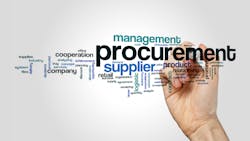Key Trends Shaping the Future of Procurement
As procurement organizations around the globe progress down the path to digital transformation, there are some clear trends emerging during this process. Whether they’re deploying Internet of Things (IoT) technologies, using artificial intelligence (AI) or experimenting with blockchain, procurement departments are testing and implementing myriad digital technologies that will help them work smarter, better and faster.
Top Trends to Watch
While the firm admits that it doesn’t own a “crystal ball,” EY says it does have a front-row seat when tracking trends and leading-edge projects from around the world. In “Ten trends shaping the future of procurement,” the firm outlines the top developments that all procurement professionals should have on their radar screens right now. Here are several that electronics buyers should keep an eye on:
- Procurement’s contribution to the overall organizational strategy will create competitive advantage. “Leading procurement functions will become part of an organization’s value stream and will be more influential in contributing to the overall business strategy, growth agenda, and competitive advantage,” EY says, adding that procurement leaders will be expanding their remit from a focus on cost leadership to enabling innovation, agility, and supply certainty.
- Technology will help reduce supplier risk. In a world where supply chain risk is top of mind for most electronics buyers, technology will continue to play a role in easing that pain point. According to EY, most organizations will have a 360-deg. view of suppliers through internal data, data from suppliers, market data and external data on suppliers’ performance (e.g., performance of suppliers with other organizations). “This will not only provide historical data about supplier performance but will also enable organizations to accurately and holistically establish supplier risk profiles and to predict risk events.”
- Procurement will be a smaller, more agile function that partners directly with business units. More activity will take place in the organization’s “virtual center,” EY predicts, and with people who are geographically embedded within business units—thus meeting the need for increased collaboration. “Category managers will also become business partners focusing on all procurement and category needs of a business unit,” it adds.
- “Touchless” procurement will gain in popularity over the next 24 months. Captured via IoT, procurement data will be used to support real-time tracking and monitoring of outcomes through continuous feedback loops across assets. “Asset-intensive industries will effectively link this data across the enterprise and connect to suppliers,” EY points out, “thus enabling touchless procurement in the next 24 months.”
- Voice-activated and bot-purchasing experiences will be the norm. Buyers of the future will be supported by seamless and intuitive purchasing experiences, regardless of underlying technology systems already in place. “What could this look like?” EY asks. “Think voice-activated purchasing experiences for goods and services, supported by natural-language search and virtual assistants.”
- Machines will be able to clean and curate their own data. Data will be continually cleansed and improved using machine learning (ML) techniques that leverage process outcomes to automatically identify and remedy data anomalies within systems. For example, the vendor master will be continually maintained using data from contracts as well as those used in pay runs.
- Procurement will take a “cautious” approach to blockchain. A hot buzzword in some industries, blockchain will be selectively used by procurement functions. EY expects some hesitation on implementing private blockchain networks due to the costs of development and deployment. “Blockchain use will most likely be limited to scenarios where there is a regulatory track-and-trace requirement,” the firm explains, “high levels of counterfeiting, or a clear business case for operational integrity.”
About the Author

Bridget McCrea
Contributing Writer | Supply Chain Connect
Bridget McCrea is a freelance writer who covers business and technology for various publications.







